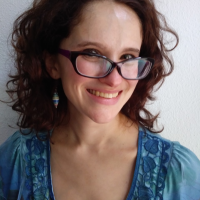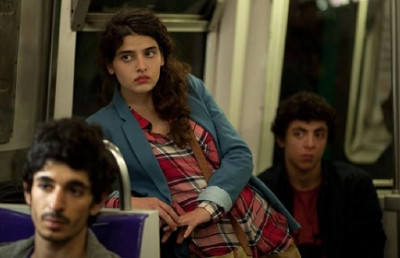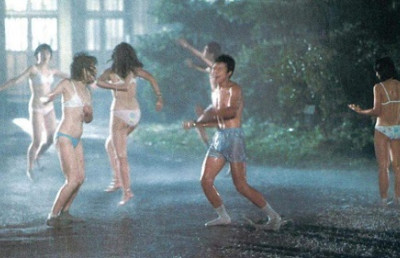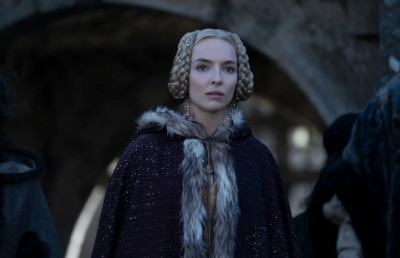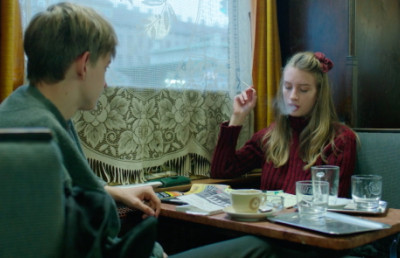Mrs. Dalloway and The Hours: The Slippery Divide Between Fiction and Reality
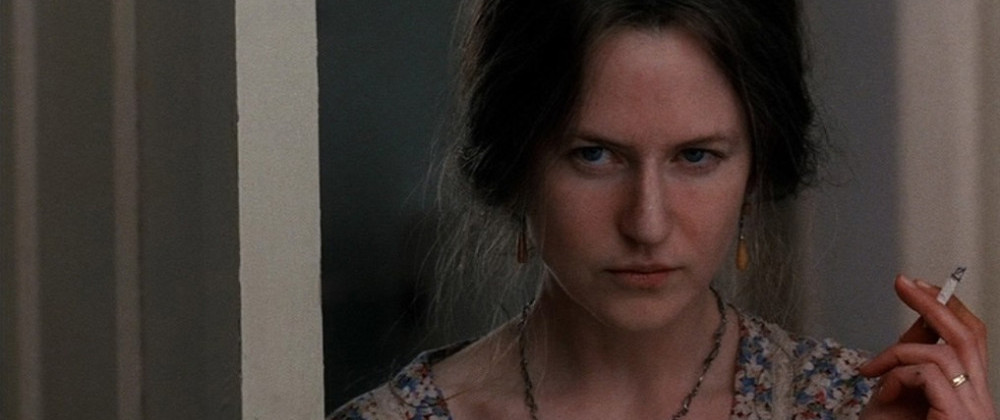
The river is heard gurgling before it can be seen. As the black screen flickers to life, the camera pans down into the river, then across the landscape. The scene changes without warning, the bubble of the river replaced with the rustle of fabric as the screen becomes filled by a woman’s torso, her hands quickly doing the buttons upon her coat. The scene changes again, the camera panned wider, and the woman marches, shoulders hunched, across her yard. Images of her outdoor walk begin to be spliced with images of her hand writing a letter, dipping her pen inside the inkwell, pausing now and then in search of the right word. Her voice reverberates: “Dearest: I feel certain that I am going mad again… I shan’t recover… I owe all the happiness of my life to you…” The woman reaches the river. She weighs her pockets with stones, then steeps herself in the water until she is drowned, a recreation of Virginia Woolf’s final moments.
So opens The Hours, a film directed by Stephen Daldry and based upon the novel by Michael Cunningham, that depicts the lives of three women whose existences are intertwined by Virginia Woolf’s novel Mrs. Dalloway. The women are Virginia Woolf, played by Nicole Kidman, a real author of the 20th century beginning to write Mrs. Dalloway; Laura Brown, played by Julianne Moore, a suburban housewife of the post-WWII era who is reading Mrs. Dalloway; and Clarissa Vaughan, played by Meryl Streep, a modern New Yorker who has been nicknamed Mrs. Dalloway. As exemplified by its opening scene, the film is a startling blend of history and fiction. It is a fact that Virginia Woolf committed suicide by filling her pockets with stones before drowning herself, and it is also a fact that she wrote a final letter to her husband containing the words read by Kidman in voiceover. Through the act of recreating historical events, however, truth becomes – necessarily and inevitably – fictionalized. The tempo of Woolf’s feet as she journeyed to the lake, for instance, cannot ever be ascertained as fact, but only an interpretation. Through such engagements with both fiction and reality, the film The Hours illuminates the ways in which its precursory novel Mrs. Dalloway engages with those same ideas.
The Hours is what critic David Cowart would term a product of literary symbiosis. In Literary Symbiosis: The Reconfigured Text in Twentieth Century Writing, Cowart discusses how, although most pieces of art necessarily borrow from one another, such acts of borrowing typically go unacknowledged. Those works that do acknowledge their forerunners engage in textual symbiosis that “transform[s] the monuments of literary history” (2). In other words, “parasitic” works of literature reconfigure the ways that readers examine their “host” texts. Such parasitic, or guest, works do not just rehash the same formula as their origin text; the James Bond series, for instance, merely plugs slightly different stories inside an invariable procedure. True guest texts shed new light upon their host, such as John Gardner’s Grendel, a novel that gives a dynamic voice to the monster of the medieval epic Beowulf (9, 17).

By reconfiguring the characters of Woolf’s novel into different eras, as well as replicating the history of Woolf writing her novel, The Hours takes part in such literary symbiosis. The three stories continually echo each other, such as depicting a character who has purchased flowers. This motif is drawn from Mrs. Dalloway, for in the first sentence, Woolf writes that, “Mrs. Dalloway said she would buy the flowers herself” (195). This line immediately establishes Mrs. Dalloway’s social status: she is married and, although not a lady, financially well-off. Yet it also reveals her independence; social standing aside, she is not above doing things by herself.
Mrs. Dalloway’s independence presents a contrast to the Virginia Woolf depicted in The Hours. Her husband, Leonard, buys flowers for her, as Virginia is mostly confined to her home due to her illness. In allowing Mrs. Dalloway the freedom to purchase her own flowers, the film’s replication of Virginia gives her main character the liberty that she herself longs for. Laura’s husband, Dan, also purchases flowers for his wife. Laura is confined not by a medical order, but by a suburban existence she does not love. Her refusal to purchase her own flowers becomes evidence for her refusal to give herself the life she wants. Clarissa is the only main female of The Hours who purchases her own flowers, thus living up to her symbiotic relationship to Woolf’s Clarissa. Even though Clarissa buys her own flowers, someone also buys them for her: Clarissa’s partner, Sally, buys Clarissa a bouquet of flowers. When, however, she sees a dozen boxes of flowers already filling the kitchen, Sally throws the bouquet aside with a sigh. Sally’s gesture in buying flowers for Clarissa is not one of oppression, but of affection. Clarissa’s flower purchasing reveals an independence being pushed too far; her freedom, just like the oppression of Laura and Virginia, has led to an emotional solitude. By echoing motifs within the intertwined plots of The Hours, as well as drawing upon Woolf’s Mrs. Dalloway, the film openly acknowledges its participation in literary symbiosis.
This literary symbiosis extends to the relationship portrayed in The Hours between readers and writers. In “The Death of the Author,” Roland Barthes declares that literary circles must stop deferring to the author in determining a text’s meaning. Writing itself, due to the inevitable gap between the signified and signifier, cannot have a fixed meaning, and so to fix a writer to a text limits the work’s wide array of meanings (142-3). The writer, Barthes posits, “can only imitate a gesture that is anterior, never original. His only power is to mix writings, to counter the ones with the others” (146). By both admitting its reliance upon the mixture of other writings and paying homage to Woolf as an author, The Hours attempts to do what Barthes believes is not possible: The Hours gives power to both creators and audience members. Woolf’s interpretation of her own work is acknowledged and explored, yet hers is not the only interpretation: the modern New Yorker and the post-WWII housewife’s opinions are given no more or less definitive weight. Although Barthes declares that giving power to the reader must come at the price of removing power from the author, The Hours declares that the reader and the author exist in a symbiotic relationship that cannot be divided.
The Hours’ continuous play with metafictional manipulation illuminates this symbiotic power. The film depicts a Virginia who can not only manipulate the characters in her novel, but who can manipulate her fellow humans within The Hours. Following the opening titles, the film presents a montage that shows the main female’s spouse coming inside the house while the principle female sleeps on. Then each main female awakens and gets ready for the day, but slowly. These motions revolve around contemplation rather than action: Virginia contemplates the opening sentence for her novel, Laura contemplates the Mrs. Dalloway upon her nightstand, and Clarissa contemplates a party to-do list. It is only once Virginia commits her first sentence to paper that the action of the story propels forward. Virginia holds the fate of each character within her hands, even though the other people in the film never appear within her novel.
But Virginia, too, is being manipulated as a character by the filmmakers. Furthermore, Virginia is not the only manipulator of fictional reality. Many of the other characters have a fluctuating awareness of the ways in which their lives mimic art. When a woman named Kitty learns the plotline of Mrs. Dalloway, for instance, and recognizes herself in the title character as a fellow housewife who hides behind a façade of confidence, she is reduced to tears. And the character of Richard, recognizing the irony of knowing a person named Clarissa who enjoys throwing parties like the Clarissa in Woolf’s novel, begins calling her Mrs. Dalloway. When Richard consciously imitates a fictional life, he drags Clarissa into an imitation of that fictional life that she does not wish to lead. Just before his suicide, he tells her, “I don’t think I can make it to the party tonight, Clarissa. You’ve been so good to me, Mrs. Dalloway… I don’t think two people could have been happier than we’ve been.” His final words, the words about happiness, are not his own – they are Woolf’s words, taken from her suicide note to her husband. In one fell swoop, Richard recognizes Clarissa as a real person, a character in a novel, and a real person different from whom she actually is.
This awareness of emulation occurs in Woolf’s Mrs. Dalloway. As a novel written from a third-person omniscient perspective, Mrs. Dalloway is also highly conscious of itself as a piece of art, seeing as real life does not permit one person to understand the thoughts of many different people. When an aeroplane flies over London, Woolf uses the opportunity to skim through the minds of multiple characters, some of whom are her protagonists, others whom never appear again in the novel. The aeroplane emits white smoke in the shape of letters, but no one can agree upon the word or its meaning: Mrs. Coates thinks it says glaxo; Mr. Bowley and a nursemaid believe it reads toffee; Mr. Bentley thinks it is a symbol of “man’s soul”; and Septimus believes it is a signal meant solely for him (211-8). Some interpretations draw upon no previous knowledge, others reference tangible external creations, and still others are immaterial yet vivid to their interpreters. Woolf illuminates how people can interpret the same event in entirely different ways; what is undeniably real to one person remains fiction to another. None of these interpretations are precisely wrong or right, but only a reflection of human diversity. Just as the characters in The Hours draw upon the outside source of Mrs. Dalloway to create their own lives, so the characters within Mrs. Dalloway draw upon outside sources to construct their lives, illuminating how tricky it can be to discern the divide between fiction and reality.
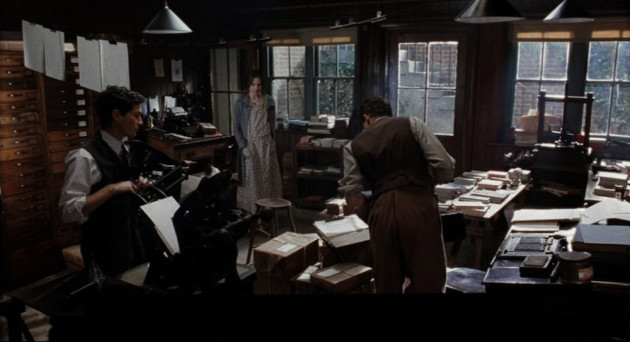
It is worth pointing out, given that The Hours is partially a cinematic recreation of her life, that the real Woolf dislikes the cinema. In “The Movies and Reality,” Woolf criticizes filmmakers for creating films that permitted people to stare at moving images without the need to consciously digest the information. She describes the typical cinematic experience of a viewer as one in which the eyes merely “lick… up instantaneously” everything on screen, while meanwhile “the brain, agreeably titillated, settles down to watch things happen without bestirring itself to think” (86). However, Woolf does not condemn cinema as a concept. Weary of film reducing complex literary works of the mind into simple gestures of exterior finery, such as one kiss conveying love, Woolf urges filmmakers to create their own language and symbols (89). She suggests that, rather than attempting to merely recreate what literature has already produced with words, cinema produce the likeness of thoughts with animated images, a realm untouched by both literature and visual arts. Woolf posits that thought itself has “the picture-making power,” as evidenced, for example, by the way in which Shakespeare’s most complex musings on humanity manifest in metaphors or allusions (90). Woolf believes that cinema’s true domain is not to emulate what has come before in literature or painting, but to animate that which cannot otherwise be expressed.
The Hours is a film that challenges Woolf’s notion of automatic looking by refusing to let a single kiss represent an entire tale of love, by refusing to rely upon only the power of words instead of utilizing the unique power of the cinema. Seeing as the work draws upon two novels, to eradicate all words would be improbable. The film instead strikes a delicate balance between silences and sounds. In one scene, for instance, Virginia is particularly engrossed in writing. The film does not declare her absorbed state aloud, but rather through the images and sounds on screen: the zoom upon her writings, the pages littered with words; the shots of her hand moving rapidly across the pages; Phillip Glass’ score in the background, ominous and exciting; the focus upon her lips as she brings a cigarette to her mouth, a process that invigorates her writing even as it drains her personal life. When Virginia is interrupted from her writing trance, the music stops, and every other sight and sound becomes louder in contrast to the enrapture of her previous minutes. In the kitchen, as she plays out a battle of wits against the cook, the kitchen maid cracks eggs into a bowl repeatedly, and the noise is amplified, the camera jolting towards the eggs each time a shell breaks; in the printing room, as she and her husband play out a similar struggle for control, the printing press slams excessively loud. The jarring sounds and sights display the agony at being disturbed from her work that Virginia does not – perhaps cannot – articulate. Meanwhile, the actual spoken words regarding daily trivialities, such as a train ride to London, reveal the disparity between conversation and thought. The Hours finds its expression through a combination of cinematic and literary techniques. Whether the real Woolf would have approved of such a combination cannot be known, but The Hours certainly embodies her wish for complex thoughts, rather than simplistic symbols, to be conceived as cinematic images.
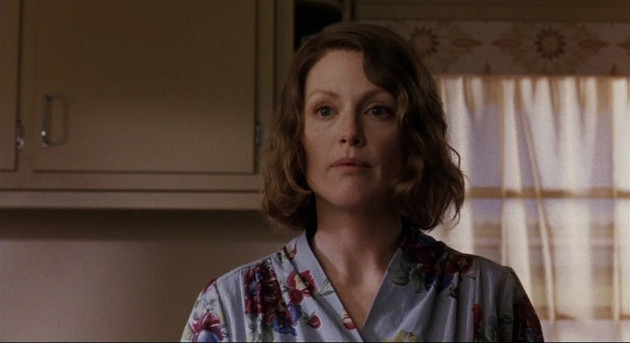
Although Woolf never created movies herself, she displays her understanding of thought having a “picture-making” power within her own writing. In Mrs. Dalloway, Clarissa Dalloway declares that the “most exquisite moment of her whole life” is when Sally Seton “kisse[s] her on the lips.” But Mrs. Dalloway cannot say precisely why this is the most exquisite moment, so she instead offers her closest approximation through figurative language: “she fe[els] that she ha[s] been given a present, wrapped up, and told… not to look at it… which, as they walk… she uncover[s], or the radiance burn[s] through, the revelation, the religious feeling” (225). Comparing Sally’s kiss to a gift highlights how blessed Mrs. Dalloway feels to be the recipient, a blessing underscored by her use of “religious feeling.” Sally’s kiss extends beyond its physicality and permeates Mrs. Dalloway’s interior, breaking the traditional gap between a person’s body and soul. But this interiority and exteriority gap is only bridged for Mrs. Dalloway. When Joseph and Peter approach and assume the girls have only been “‘star-gazing,’” Mrs. Dalloway feels that their interruption is “shocking” and “horrible”: “It was like running one’s face against a granite wall in the darkness” (225). The image of sudden violence, of physical pain, makes Mrs. Dalloway’s heartache visceral. The image also makes visceral the great divide between people. A wall hides Mrs. Dalloway’s actions and feelings from the rest of the world, underscoring the inherent divide between one person’s reality and another’s. Both The Hours and Mrs. Dalloway use the “picture-making” power of thought to create concrete images from intangible feelings while exploring the gap between individual human experiences, between what one person deems reality and the other deems only imagined.
By engaging in literary symbiosis and metafictional practices, giving power to both readers and writers, and utilizing the unique abilities of the cinema, The Hours illuminates Mrs. Dalloway’s preoccupation with the slippery divide between fiction and reality.
Writer Anna Tatelman does a close textual reading of how the film The Hours intertwines Virginia Woolf’s novel Mrs. Dalloway across three different time frames, three different female characters, stretched across the layers between fiction and meta-fiction. Director Stephen Daldry invokes Woolf’s non-linear style by cutting across Woolf’s life history and those of her characters.
Works Cited
Barthes, Roland. “The Death of the Author.” Image-Music-Text. London: HarperCollins UK, 1977. 142-148. Web. 30 Mar. 2014.
Cowart, David. Literary Symbiosis: The Reconfigured Text in Twentieth Century Writing. Athens: University of Georgia Press, 1994. eBook.
Daldry, Stephen, dir. The Hours. Perf. Streep Meryl, Kidman Nicole, and Moore Julianne. Miramax Films, 2002. Film. 27 Mar 2014.
Woolf, Virginia. “Mrs. Dalloway.” Ed. Francine Prose. The Mrs. Dalloway Reader. New York: Harcourt, Inc., 2003. 195-371. Print.
Woolf, Virginia. “The Movies and Reality.” Harry M. Geduld. Authors on Film. Bloomington: Indiana University Press, 1972. 86-91. Web. 30 Mar. 2014.

